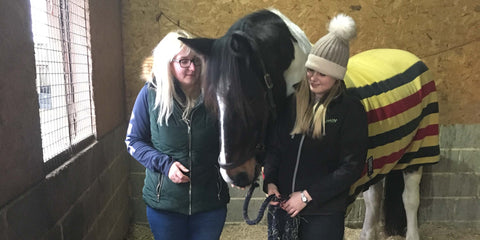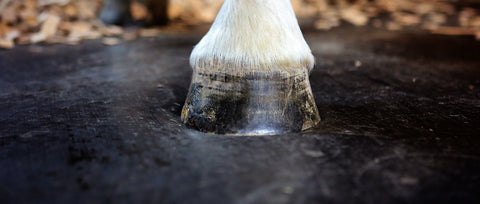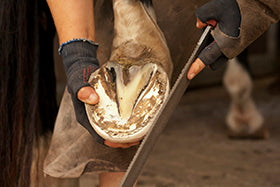The geriatric horse
We are sorry but this page is only available in English.
Written by: Sharon Smith
A geriatric horse is one with progressive physical problems, that impact on quality of life as they age. Horses tend to be in their 20's and 30's when they are considered geriatric although in some cases it can happen in their early teens. The majority of problems can be grouped into: musculoskeletal disorders; digestive tract problems; breathing difficulties and complications from PPID[1].
quality of life as they age. Horses tend to be in their 20's and 30's when they are considered geriatric although in some cases it can happen in their early teens. The majority of problems can be grouped into: musculoskeletal disorders; digestive tract problems; breathing difficulties and complications from PPID[1].
Musculoskeletal disorders
Early experiences have whole-life impacts. Tendon and ligament injury in horses over 18 months old will create scar tissue and vulnerability to further damage, for life. In horses under 7 years, over-work and/or poor nutrition choices will cause bone deformities and joint problems that could lead to nerve damage and arthritis, even in early maturity[2]. Mature horses experience wear and tear from prolonged periods of poor posture eg. during training, or while eating from a haynet with either the head twisted or held high[3]. Accidents happen, but damage from training and management decisions is avoidable.
A correct diet and suitable exercise will ensure healthy growth and repair. But joints, tendons and ligaments need care 24 hours a day. Horses with mobility pain often avoid laying down if they feel unable to rise quickly enough when they feel the need. A friend nearby acts as a reassuring ‘lookout’ while they feel vulnerable on the floor. Provide the horse with enough room to keep moving gently all day and a suitable surface to prepare themselves to lay down or stand up easily. Vets have remarked on the willingness of horses to lay down on Comfortstall flooring, even in unfamiliar surroundings.
If possible, horses spend most of their day eating. Encourage the horse to  stretch over their back when eating, but also ensure they are standing square with equal loading on the forelegs, by presenting it slightly above the floor – such as in the Forager. This is especially important for young sports horses with long legs and short necks! A habitually unhealthy stance, such as one leg stretched out in-front of the other can last a lifetime by causing differences in the front hooves (see photo) and unhealthy compensatory movement patterns that limit performance. Elderly horses may also find prolonged eating from the floor, or grazing very short grass, difficult due to musculo-skeletal pain. This may also account for some weight loss.
stretch over their back when eating, but also ensure they are standing square with equal loading on the forelegs, by presenting it slightly above the floor – such as in the Forager. This is especially important for young sports horses with long legs and short necks! A habitually unhealthy stance, such as one leg stretched out in-front of the other can last a lifetime by causing differences in the front hooves (see photo) and unhealthy compensatory movement patterns that limit performance. Elderly horses may also find prolonged eating from the floor, or grazing very short grass, difficult due to musculo-skeletal pain. This may also account for some weight loss.
Digestive tract problems
Choke, gastric ulcers and colic can occur at any time, but underlying illness may leave geriatric horses more susceptible. Dental pain and damage affect the ability of a horse to drink and chew properly. Very cold water, at any time of year, could cause pain. Some older horses start to experience bouts of choke. If not choke, then the poorly chewed forage could go on to cause an obstruction colic. Steaming hay softens the plant stem and the warmth can also encourage horses with sensitive teeth to eat, especially in winter. It may be useful to ensure an elderly horse eats their hay ration at a steadier pace. Due to its design, the Forager is not likely to frustrate a horse while he is encouraged to take smaller mouthfuls. 
The equine stomach acid tap never switches ‘off’ under normal circumstances, unlike a human stomach. The most common risk factors for equine stomach ulcers are lack of forage and going too long without eating. Research suggests a link between harmful micro-organisms and ulcers in the low (glandular) part of the stomach, where ulcers are more difficult to detect[4]. Steaming forage thoroughly kills harmful bacteria, viruses and fungi.
Thermoregulation, the automatic ability to maintain a core temperature, is often poor in older horses. They may need extra protection against the elements, both from the weather and cold ground. The horse’s caecum (between the small and large intestine) is a large sack full of ‘good’ bacteria that thrive on plant fibre (eg. cellulose) and in doing so create heat to warm the horse’s core. Extra forage in winter will help keep them warm and maintain bodyweight. Starch and sugar diets don’t have the same benefits.
Breathing difficulties
Equine Asthma (also known as Recurrent Airway Obstruction) is the new common name for an allergic, inflammatory response of the lungs. It is caused by repeat exposure to fungal spores and microscopic airborne particulates – a pollution we cannot see. The initial attack results in breathing difficulties and prescribed medicines that are not permitted in competition. But also, the horse will be ‘sensitised’ for the rest of their lives, so the slightest deterioration in air quality could trigger another attack.
Asthma is not seen in feral horse populations. It is a man-made disease. Maintaining a dust-free, low pollution environment from a young age will help sustain a horse’s career and performance level, and health, in later life. For horses that cannot be in the fresh air all day, the air inside must be kept free or pollution and irritants. Ammonia from urine impacts horse airways before we can smell it. Ensure urine is not allowed to putrefy on, or under, flooring. Comfortstall prevents urine soaking underneath it. Steaming hay is a proven method for almost eliminating airborne particulates. But steaming also maintains this clean state for the many hours the horse is eating it too. Regular use of a nebuliser – with or without prescription medication - can help clear the lungs of particulates. The Flexineb 2, can deliver an aerosol capable of penetrating deep into the lung where EA develops.
PPID (Equine Cushing’s Disease) and oxidative stress
In the past, some clinical signs of PPID, eg. lethargy and loss of topline muscle, were mistaken for natural aging. It is a disease develops over time and affects 1 in 5 horses over 15 years old[5]. Most equine professionals agree that environment plays a role in triggering the condition. PPID is a malfunction of the pituitary gland at the base of the skull resulting in a failure to regulate production of a hormone, called ACTH. When ACTH goes unchecked, there is over-production of the stress hormone, cortisol. Long periods of elevated cortisol and stress damage body and brain[6]. For example, PPID is now known to be a major risk factor in laminitis.
The inhalation of ultrafine (<0.1 micron) organic particulate pollutants [7], metabolic dysfunction, a high-carbohydrate diet and other internal and external sources have been found to increase Reactive Oxygen Species (ROS) in the body. ROS damage cells, including brain cells, a major cause of mental and physical aging. A potential link between ROS and PPID has been identified, but yet to be explored[8], while its role in insulin resistance[9] (and laminitis) and early life stress[6] is better understood. Unfortunately the answer isn’t as simple as feeding ‘anti-oxidants’[10]. Among sensible anti-aging precautions, to avoid PPID it may be helpful to: meet recommended vitamin and mineral levels in the diet but not to huge excess; avoid obesity and grain diets, and minimise exposure to ultrafine airborne particulates, throughout life.
In summary, how soon a horse gets ‘old’ depends on a number of factors. Some factors may be genetic or accidental, but many are under our control. Delaying ‘old age’ starts with correct foal management and then life-long attention to training, management and environment. Delaying the onset of old age will allow horses to reach their full potential, and both horses and humans to remain safe and sound for longer.
References
[1] Brosnahan, M. M., & Paradis, M. R. (2003). Demographic and clinical characteristics of geriatric horses: 467 cases (1989–1999). Journal of the American Veterinary Medical Association, 223(1), 93-98.
[2] Reed, S. M. (2018). Cervical vertebral stenotic myelopathy. [online] Beaufort College Educational Trust, Gerald Leigh Memorial Lectures 2018: Wobbler. Available from: https://youtu.be/yTJPeh5lvu4 [Date accessed: 29 June 2018]
[3] Jenks, A. (2010). Post-treatment Care and Management. Osteopathy and the Treatment of Horses, 195.
[4] Rendle, D., Bowen, M., Brazil, T., Conwell, R., Hallowell, G., Hepburn, R., ... & Sykes, B. (2018). Recommendations for the management of equine glandular gastric disease. UK-Vet Equine, 2(1), 3-11.
[5] Ireland, J. L., & McGowan, C. M. (2018). Epidemiology of pituitary pars intermedia dysfunction: A systematic literature review of clinical presentation, disease prevalence and risk factors. The Veterinary Journal.
[6] Sato, H., Takahashi, T., Sumitani, K., Takatsu, H., & Urano, S. (2010). Glucocorticoid generates ROS to induce oxidative injury in the hippocampus, leading to impairment of cognitive function of rats. Journal of clinical biochemistry and nutrition, 47(3), 224-232.
[7] Heusinkveld, H. J., Wahle, T., Campbell, A., Westerink, R. H., Tran, L., Johnston, H., ... & Schins, R. P. (2016). Neurodegenerative and neurological disorders by small inhaled particles. Neurotoxicology, 56, 94-106.
[8] Donaldson, M. T., McDonnell, S. M., Schanbacher, B. J., Lamb, S. V., McFarlane, D., & Beech, J. (2005). Variation in plasma adrenocorticotropic hormone concentration and dexamethasone suppression test results with season, age, and sex in healthy ponies and horses. Journal of veterinary internal medicine, 19(2), 217-222.
[9] Houstis, N., Rosen, E. D., & Lander, E. S. (2006). Reactive oxygen species have a causal role in multiple forms of insulin resistance. Nature, 440(7086), 944.
[10] Carocho, M., & Ferreira, I. C. (2013). A review on antioxidants, prooxidants and related controversy: natural and synthetic compounds, screening and analysis methodologies and future perspectives. Food and chemical toxicology, 51, 15-25.











